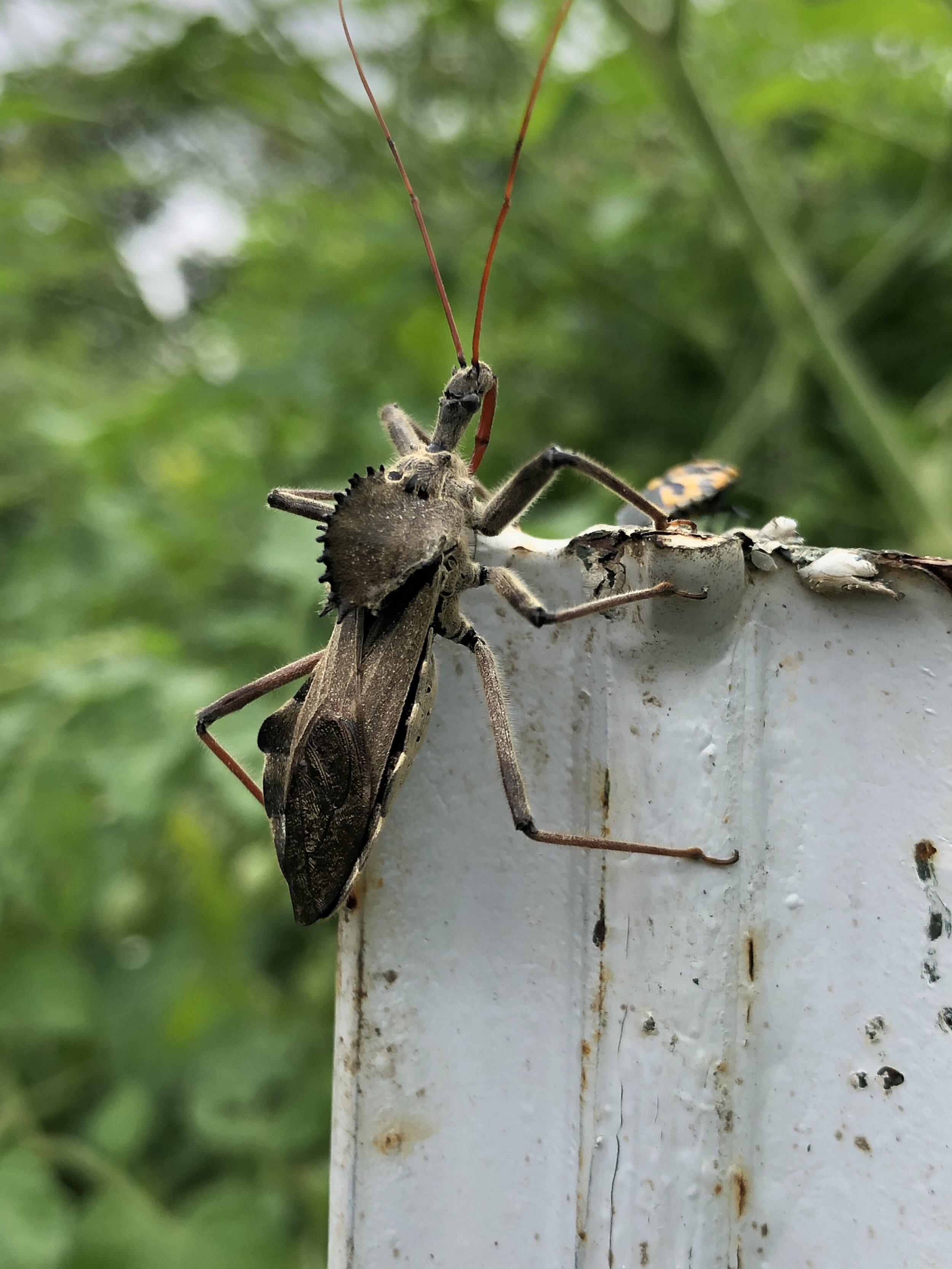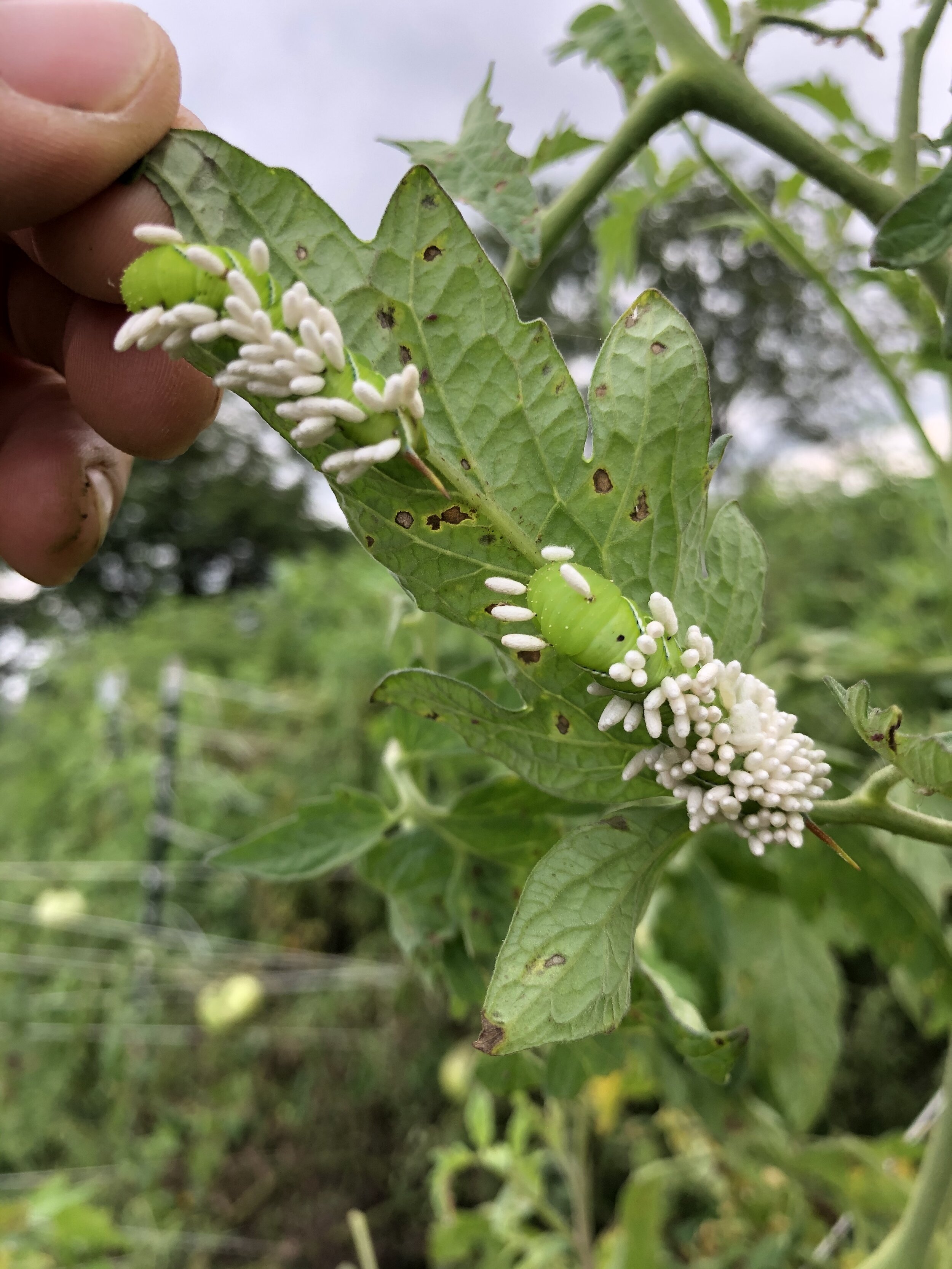Tackling Common Garden Pests
Emily Ellis
Where there are plants, there are pests. Every farmer or gardener has had to battle with tomato hornworms, aphids, or cabbage worms at one point or another, and at Oak Spring’s Biocultural Conservation Farm (BCCF), that job falls to Manager of Integrated Pest Management Nicke Sette, who is in charge of building the farm’s defenses against a slew of crop-munching insects.
An IPM system can attract insects like assassin bugs to help combat your pest problem. Photo by Nick Sette.
Unlike a pest-control pest strategy that broadly wipes out all pests at once through the use of pesticides (which can harm far more than the targeted insects), an Integrated Pest Management (IPM) system seeks to build an ecosystem that manages both pests and beneficial insects in a healthy, balanced way. These techniques include creating habitat that attracts predatory bugs such as parasitoid wasps, praying mantises and assassin bugs (click here to read more about beneficial insects and how to attract them), making environments unsuitable for pests through the use of deterrent plants, traps and barriers, rotating crops to avoid annual infestations, and some organic spraying.
Insects like praying mantises can be allies in the war on pests. Photo by Nick Sette.
“It’s a little bit of warfare, a little bit of ecosystem building,” said Nick. “It’s creating the best ecosystem so you have to do as little work as possible.”
The main offenders on the BCCF fall into the categories of specialists and generalists: insects that use specific types of plants as their hosts, and insects that interact with a wider range of species. While the farm has grown tens of thousands of pounds of heirloom produce for local food banks and Oak Spring’s kitchens since it was established in 2019 (and has donated over 11,000 pounds so far for the 2020 growing season alone), it still has to deal with its fair share of pesky insects, and is in the early stages of building a long-term pest management strategy. Scroll down to read about some of the primary-trouble makers at the BCCF, and ways to tackle them.
Tomato Hornworms
Tomato hornworms after a parasitoid wasp has gotten to them. Photo by Nick Sette.
Have you ever plucked a luscious tomato off the vine for your salad, only to find it bored through with dripping holes? That’s the work of the tomato hornworm - a large moth caterpillar that’s just as fond of juicy heirloom tomatoes (as well as their new leaves and stems) as humans are. They will also nosh on other plants in the solanaceae family, including eggplant, potatoes and tobacco.
What hornworms become. Photo by Nick Sette.
Tomato hornworms are Nick’s favorite farm pest, as they transform into the beautiful (but troublesome) hawk moths, which lay their eggs on the undersides of tomato plants. Fortunately, the fat caterpillars are easy to hand-pick off plants (the BCCF feeds them to their chickens) and are a favorite target of braconid wasps, a family of parasitoid wasps that lay their eggs under the hornworm’s skin. The larvae feed on the caterpillar’s insides, eventually chewing their way to the surface and forming clusters of cone-like cocoons. If you spot a hornworm lumbering along at this stage, it is likely close to death - giving gardeners a front-row seat to a fascinating example of parasitism without having to lift a finger.
Cucumber Beetles
A cucumber beetle on a tomato - they menace more than just their namesake vegetable. Photo by Nick Sette.
Cucumber beetles are particularly troublesome for young cucumber and other melon plants that haven’t yet grown to have a good defense against their onslaught. The small, striped adult insects feed on the foliage, while the larvae attack the roots. Covering plants with row covers until they start to flower can be a helpful defense, as can spraying neem oil, a naturally occurring pesticide found in seeds from the neem tree (a species native to India), which causes insects to reduce or cease feeding on the sprayed plant.
aphids
Insect pests are either chewers or suckers, explained Nick; tiny, sap-guzzling aphids fall into the latter category. There are over 4,000 aphids of species worldwide, some which are bigger pests than others. They are particularly troublesome for young plants and seedlings, feeding on the tender new growth and leaving a trail of “honeydew” (a sugary waste that is not nearly as pleasant as its name suggests) which attracts other pesky insects.
A column by Mrs. Mellon on chewing and sucking insect pests from The Middleburg Chronicle. Found in the library by BCCF farmer Caitlin Etherton.
OSGF founder Bunny Mellon also had trouble with aphids in her garden, writing in a 1938 column for The Middleburg Chronicle, “Everywhere I look my eyes light on masses of green aphides.” She pointed out that such sucking insects presented a particular challenge, since “their damage is well under way by the time I have discovered it.” Mrs. Mellon recommended tackling aphids with a spray bottle of nicotine and soap; soapy water is just as effective antidote for these pests today as it was in the 1930s. The BCCF also uses neem oil to treat infested plants, which kills soft-bodied insects like aphids; other methods include knocking them off with water pressure and purchasing ladybugs to do the dirty work for you.
Onion Maggots
Onion flies trapped on sticky tape (the row covers in the background also help to control this pest). Photo by Nick Sette.
Onion maggots (the pale, squirming spawn of the tiny onion fly) tunnel their way through the bulbs of onions and similar plants like leeks and shallots. Unlike many insects on this list, onion maggots prefer cool, wet weather and are particularly problematic in the early spring (click here to read BCCF farmer Caitlin Etherton’s thoughts on dealing with onion maggots in the time of COVID-19), although three generations of this pest emerge throughout the year in many regions.
The BCCF has found that covering seedlings is an effective way at keeping onion flies from laying eggs on the stems; the flies are also drawn to yellow sticky tape, so be sure to put some up when the adults first begin buzzing around in May or so. Rotating the location of your onion crop if possible can also help prevent an infestation, and tilling the soil after you have harvested can kill any lingering larvae.
Cabbage root maggots and their flies look and behave in a very similar way to onion maggots, except they chew, well, the roots of cabbage and other brassica crops. Sticky tape is also a good defense for those pests.
Cabbage Worms
Photo by James Lindsay
Have you ever found your kale, cabbage, or other cruciferous vegetables riddled with holes? Blame the cabbage worm, which does not limit its reign of terror to just its namesake crop. Cabbage worms grow up to be white cabbage butterflies, which look quite pretty fluttering among your vegetables until you realize that they’re laying the eggs of their leaf-munching offspring. BT (Bacillus thuringiensis kurstaki), which contains a bacteria strain that is toxic to moth and butterfly larvae, can be used to control pests like cabbage worms. Nick pointed out that it’s important to use this pest-control method sparingly, as there are many butterfly species are important pollinators or are at conservation risk.
Squashy caterpillars like cabbage worms are also often targeted by parasitoid wasps, so the problem may handle itself if you have enough of these helpful insects buzzing around your garden. It’s worth noting that these wasps will target good caterpillars as well (no pest-attacker is perfect) but that an effective IPM system should be able to support a balanced variety of beneficial insect species.
As pollinators, these wasps are often attracted to fragrant, umbrella-shaped flowers and herbs such as as yarrow, Queen Anne’s lace, zinnias, fennel and dill.
Squash Vine Borer
Photo by Lisa Brown
If you pop out to your garden one morning, excited to tend to your perky squash plants, and are devastated to find that the once proud crops are wilting, it could be the work of the squash vine borer. The larvae of these bright orange, clear-winged moths burrow into squash vines, eating them from the inside out, so that it can be hard to notice the damage until it is too late to save the plant. Row covers can be a helpful deterrent to keep the borers from laying their eggs at the base of your squashes, as can be rotating your squash crops every two years or so, as the larvae overwinter in the soil.
While we’re on the subject, squash bugs are the other enemy of these poor vegetables. Nick has found that planting deterring plants among the crops (plants that smell bad to some insects) such as marigolds, cilantro, and especially basil can create a helpful barrier against these pests.
Flea Beetles
Little and cute, but still a big pest. Photo by Vengolis.
Flea beetles are tiny critters that can jump up like fleas when threatened. Unlike many pests on this list, most flea beetle species are generalists, meaning that they attack a wide range of plants. Plants in the Brassica family (broccoli, cabbage, kale, radishes, and bok choy) and Nightshades (tomatoes, peppers, and eggplants) are particularly susceptible. The beetles create shot-like holes in foliage and can cause particular problems for young seedlings, so it’s a good idea to keep an eye out for them early in the spring.
One method the BCCF uses to control these pests is the application of beneficial nematodes: microscopic roundworms that occur naturally in the soil and attack the soil-dwelling larvae of pests like the flea beetle (they won’t hard beneficial organisms like earthworms). Neem oil can also help keep them off your plants.
Want to learn more about the BCCF and its projects? Visit their page here.











